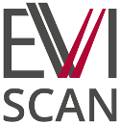One solution for various materials
EVISCAN acquires high-quality digital images of prints from a broad variety of relevant non-porous and semi-porous surfaces. Metals, pottery, glass or plastics can be processed even when they are wet, sticky or dirty. Even latents completely invisible to the human eye, e. g. trace evidence covered with black layers of soot, can be preserved with EVISCAN with no necessity to even touch the exhibit.
[wonderplugin_carousel id=”3″]



